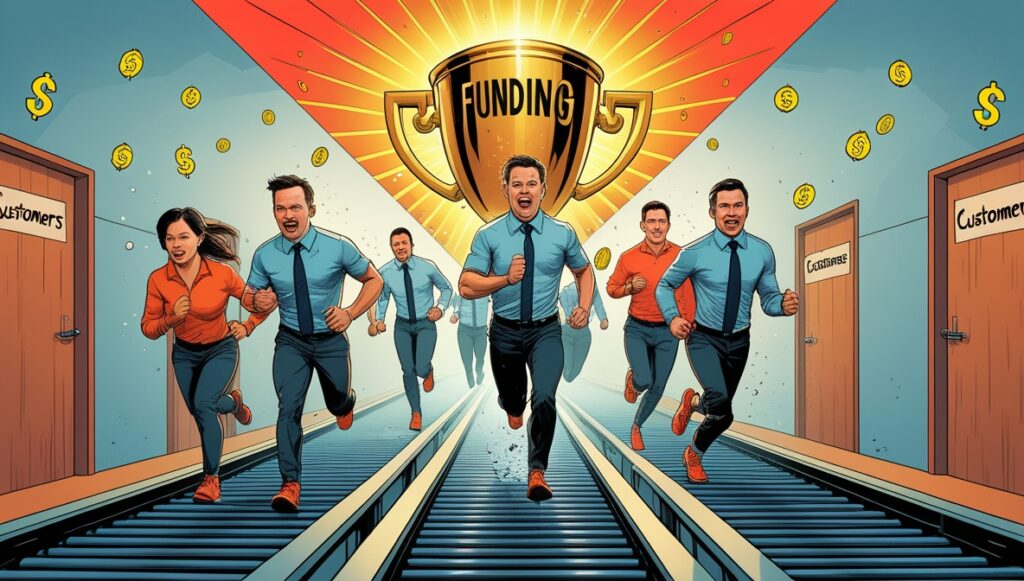
Having an idea is probably the easiest step in a company’s value chain.
I have a brilliant idea, revolutionary in my mind: I start by creating a POC or a well-made pitch and go knocking on investors’ doors.
In the mind of a “startupper,” this first step, sublimated by fundraising, is something fundamental: for many, it represents a stronger feeling than declaring your love to the girl you’ve been dating your whole life.
This step creates such a dose of adrenaline and self-esteem that often the first thought is:
"we're gonna make it big"Code language: JSON / JSON with Comments (json)This phrase bounces in anyone’s head when they look at the company’s 6-figure bank account and start to smell the money received from generous investors.
Over time, this corporate “drug” becomes an addiction: it is a thousand times easier to find a funding round than new customers.
To grow, you have to meet hundreds of potential customers and convince them that your product is fantastic, while to convince an investor you have to knock on many fewer doors and the leverage is different: you are not selling something tangible, but only the idea and the fact that it “will change the world” – which then maybe it really will change it, but it’s not a given.
Sometimes a histrionic founder, a well-made pitch, and a compelling narrative are enough to convince an investor to bet on you.
But let’s try to analyze what happens, what are the pros and cons, and why this is a diabolical mechanism that risks generating three-headed monsters, devoid of any commercial appeal.
The paradox of apparent prosperity
A phenomenon that is spreading like wildfire is the so-called “cash-rich, revenue-poor syndrome” (the phrase is not mine, but it makes the idea well): an abundance of capital not supported by adequate revenues. I am rich because an investor believed in me, but my customers still don’t believe in it enough to make my journey virtuous.
The initial funding and the various growth rounds of the company, which by their nature should be a strategic financial means to achieve specific business objectives, are becoming, in some contexts, the only means of sustenance:
The "so-and-so" company has had yet another round of financingCode language: JavaScript (javascript)Following this announcement, a cloud of journalists, bloggers, and startuppers celebrates by popping champagne and toasting to success.
In reality, they should be celebrating the fact that the company has achieved a business objective such as increasing customers, improving profitability, growing revenue, or expanding into new markets.
Celebrating a financing is like being happy because your grandmother has increased your monthly allowance, but you look at yourself in the mirror and you are the same unemployed person as always, who spends the money to go out with friends, pay for cigarettes, and buy a car, but not to look for a job.
The macroeconomic context of abundant capital
In the last ten years, the venture capital market has experienced an unprecedented influx of liquidity, with significant repercussions also at the European and Italian levels.
Recent data show exponential growth: in Italy, investments in venture capital have increased considerably between 2013 and 2023, reaching a total of over 8 billion euros, as can be read in many reports. I report one as an example: p101.
The average amount per round has grown a lot, painting a picture of a market flooded with capital, where funds not only have more money to distribute, but they also do it in larger blocks. The result is an ecosystem where the availability of funds has become the norm: it is normal to receive a lot.
The nervous investor in the competitive market
Since it is complicated to understand what the next killer application actually is, venture capital funds have faced each other in a context of strong competition to secure the startups that “seemed” to be the next big idea.
This competition has given rise to a phenomenon known as “Fear Of Missing Out” (FOMO), or the fear of losing an investment opportunity: what do I do? Do I let this startup slip away that, if it went well, could cover me in money? Come on, let’s drop a hundred on it.
This is not just an emotional aspect, but a factor that can alter operational decisions. Investors, driven by the need to act quickly, skip the crucial stages of financial and market analysis, basing their decisions on “hype” and intuition, rather than on objective data.
This reminds me of a startup I followed some time ago. We were in the middle of the blockchain hype and the startup in question had an interesting idea, but not a product.
Arriving as a technical analyst of software solutions, my judgment was substantially negative: I stressed the fact that there was nothing evaluable, so the only evaluation could be made on the people, not on the technical part, which was completely absent.
A few years after that event, the result was that the startup received funding, but in substance it never produced anything concrete and what still survives are Telegram channels of customers now resigned to having lost their money.
This is a case of a dysfunctional process: money arrived in the hands of people with an idea, who remained as such, in the absence of a product with a real market.
What drives this dynamic?
Investors are often driven by a captivating narrative or a charismatic personality rather than a solid business model or tangible growth metrics.
I remember another meeting I had about ten years ago with a startup that wanted to launch a new search engine, which would overcome the logic of Google and could give more precise and timely results, what is now becoming a reality with tools like Perplexity or with Google’s AI mode.
The idea was innovative, it was based on then consolidated products: if I remember correctly, it used Lucene as a search engine. Everything was driven by a brilliant, charismatic figure, capable of fascinating anyone. He had only one flaw: he was not a technical person and, when he explained the amazing innovations of his solution, the narrative was lacking, but as long as he stayed out of it, he was absolutely fascinating.
For this reason, despite my perplexities, the startup managed to raise a huge amount of funding. The product saw the light of day, but in the end it failed to take off and it all ended up in court.
The disconnect between fundraising and business
Fundraising, as it is perceived, becomes a game of psychology and persuasion:
Let's make a pitch that rocks, let's tell a story that makes people dream and you'll see that the money comesCode language: JavaScript (javascript)While building a company that produces income is a completely different activity, of pure pragmatism, one could say.
The narrative of a future dream is easier to sell than a product that has to solve a current problem, that your customers have and are willing to pay for: we don’t have to invent a problem and then solve it, but we have to solve an existing problem.
Venture capital accepts high risk, is fascinated by dreams and the possibility of exceptional returns.
This strategy, also called “power-law distribution,” assumes that most of a fund’s bets will fail or return a modest capital, while success will be guaranteed by a small number of companies, those few, and sometimes even lucky, startups that manage to generate a much higher return and, by themselves, repay dozens of evaluation errors: even in the face of many failures, a single startup could make the whole fund profitable and, since the future is not predictable, we invest in the ideas that seem best to us, without hesitation.
Although it is a strategy with a rational basis from the fund’s point of view, this approach creates as a priority the frantic search for a possible “unicorn.”
It is preferred to invest in a “visionary” startup, but with zero revenue, rather than in a company with slow but steady growth: slowness does not pay off, the winning idea that develops in a short time pays off.
For this reason, if the company exceeds 5 years of life without having achieved a significant turnover, it is likely to be abandoned by investors, even in the presence of good margins and constant growth.

The obsession with fundraising and the loss of focus on the customer
The tangible and certain risk is that companies lose sight of the customer or, better, that it no longer becomes the main focus, becoming entangled in product growth that is not sustainable with revenues, but only with the financing rounds obtained, which generate products that, according to market analysis, nobody wants: but the company, with its coffers full, is unable to realize it because it has now lost its corporate objective and is no longer able to focus.
This reminds me of my first startup, or rather company, since at that time we were not yet talking about startups.
It was a vertical search engine for job offers.
At the time, our “funder” was Adsense: we made 90% of our turnover with a single client and our goal was only to increase the number of visitors, increasing our data and, consequently, our revenues. But we were focusing only on this.
We had not understood that it was necessary to differentiate, to make the income multiple, to spend more time on the commercial side.
This conviction had made us lose sight of the customer and, above all, it closed our eyes and ears when a real investor had decided to put money on the table to make us grow commercially.
The effect was that those who wanted to finance us went to finance another aggregator, which over time became the market leader, while we disappeared when our only funder, Adsense, decided to close, slowly but surely, the tap.
Attention to burn rate and financial management
The “burn rate,” or the speed with which a startup consumes its capital, is one of the most crucial metrics for assessing the sustainability of a not yet profitable company.
It is calculated by considering both total expenses and revenues and provides an indication of the financial autonomy time before running out of resources.
One might think that excess financing is able to extend the life of a startup, when instead it could act as a negative catalyst that accelerates the burn rate.
Having large sums in the bank can lead to superfluous expenses that quickly erode capital.
This includes hiring staff before it is necessary, leasing luxurious offices, and investing in untargeted marketing.
Thinking back to my experience, I certainly made at least one of these mistakes.
Clearly, expenses increase the burn rate, putting the startup in the position of “running in place.” Experienced investors see a high burn rate as a “red flag” if it is not justified by a clear and proportional growth in revenues.
A large availability of capital can also generate the dangerous “illusion of time,” leading to the belief that you have unlimited autonomy to achieve profitability: no guys, time is not infinite and if you don’t grow, it’s better to close down and think about something else.
As already written in another article, experts like Enrico Pandian remind us of the 2-week strategy:
"If you can't validate your idea in 2 weeks, you're probably building a sandcastle."Code language: JSON / JSON with Comments (json)Full coffers extend this perception of time abnormally, but the basic concept remains the same: the time to validate an idea is not infinite and the more you lengthen it, the more you risk building something that nobody wants.
The fall of giants
Let’s see some striking cases of overcapitalization that have led to the failure of startups once considered “unicorns.”
- Theranos: Founder Elizabeth Holmes raised over $900 million in six years without a working product. The entire company was a fraud, built not on validated technology, but on a seductive narrative of medical revolution and the founder’s charisma. The collapse of Theranos shows how investors can be vulnerable to an irresistible “story.”
- Juicero: This case is the archetype of the lack of “product-market fit.” The startup raised $120 million for a $700 juicer, tied to the purchase of expensive pre-packaged bags. An idea that solved a trivial and non-existent problem was pushed to failure by an excess of capital that encouraged an irrational business model, dismantled by a youtuber able to squeeze their bags with his hands.
Who will be next?
It is not easy to say, many companies have business models that are difficult to sustain. Think for example of Klarna, a model based on “buy now, pay later,” but Klarna’s own customers have entered a whirlwind of unpaid micro-loans that has increased the company’s financial exposure, calling into question its long-term sustainability. Only time will tell if Klarna, thanks to its capital, will be able to restructure its model to face these challenges or will remain trapped in this not very virtuous cycle.
These cases show that capital, if not managed with discipline and if not supported by a solid business model, can become a real curse that accelerates failure rather than guaranteeing success.
Failure is often a fundamental lesson
Failure is painful, both financially and mentally, but sometimes it becomes essential for growth.
We often hear about Dyson and his 5126 failures that then led to his first successful product: the bagless vacuum cleaner.
For those who have experienced failure firsthand, the best thing they can do is analyze and learn from their mistakes.
Let’s think about it: a failure is more educational than a success. I remember the failure and it ensures that on the next attempt some things are no longer underestimated, while success anesthetizes everything and makes us believe that our work is perfect.

But the venture capitals
Perhaps something is moving on this aspect as well: after years of excesses, overvaluations, and money scattered in a thousand directions, we are witnessing a change. Not in the birth of new companies, but in the search for companies with full coffers but few orders, in the hope that, by recalibrating products and the market, they can “wake up” from their torpor and trigger that virtuous growth system that investors expect.
Yes, but the companies?
The problem, however, could always be the company that, due to its full coffers and loss of focus, fails to understand how useful a new guide would be, capable of changing the situation that, slowly but surely, is leading them to failure.
Conclusions
So let’s look at the company coffers with a different eye, let’s always ask ourselves: do we really need all this money? Are we spending it well? Are we growing in terms of customers and turnover? If some or all of these answers are negative, perhaps it is time to stop and reflect and truly invest in growth, perhaps not in the product, but certainly in targeted commercial and marketing.




